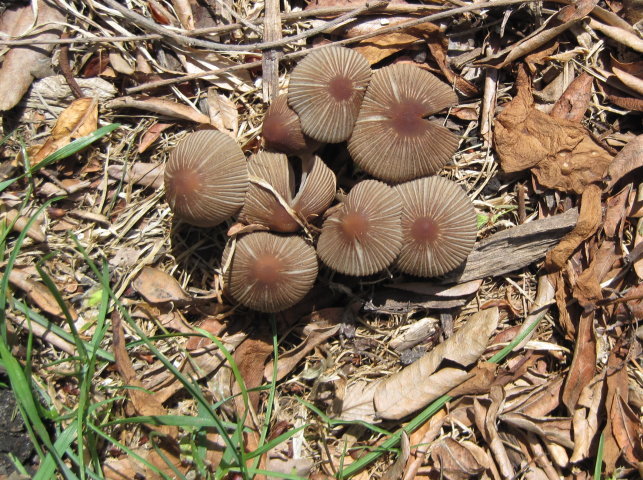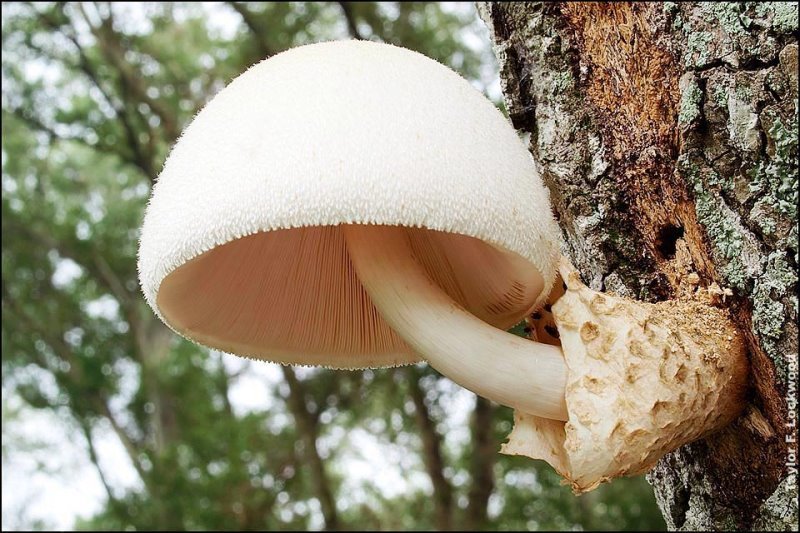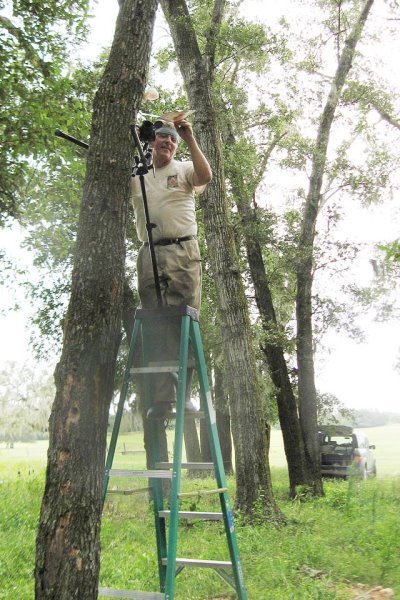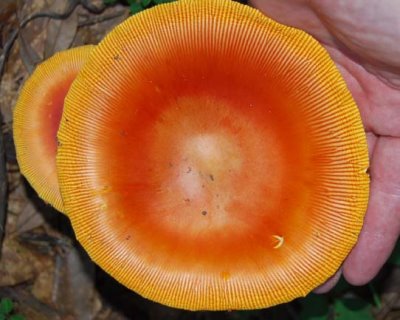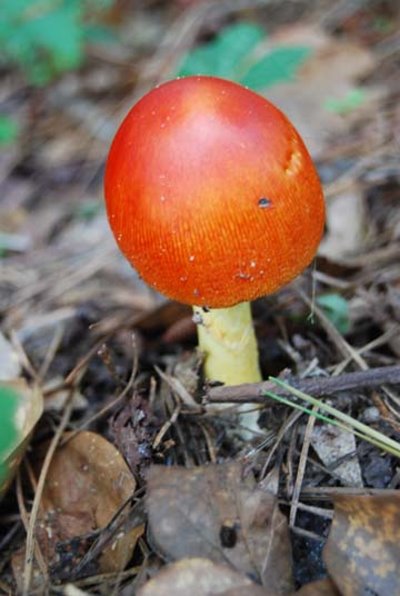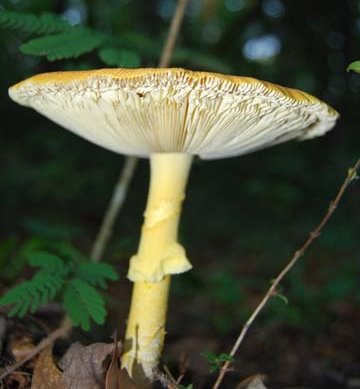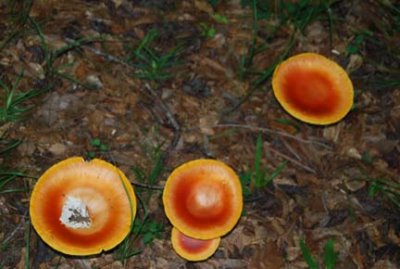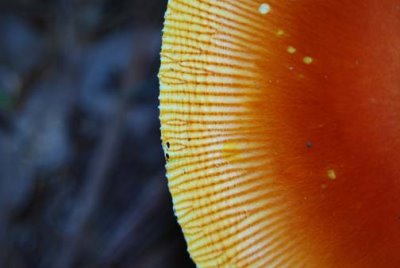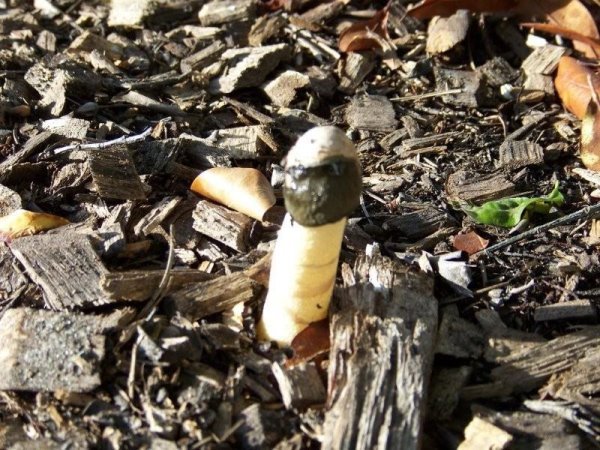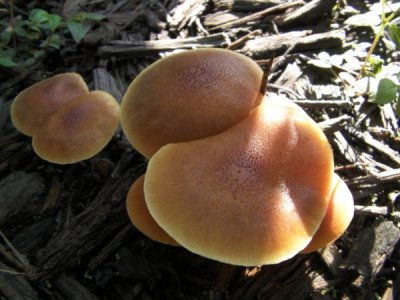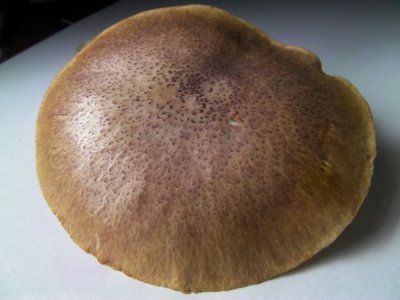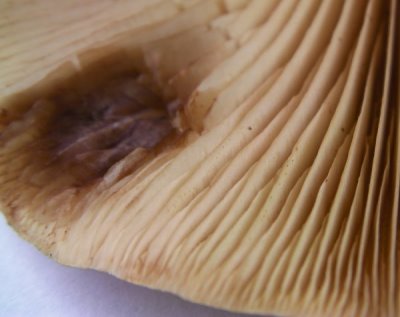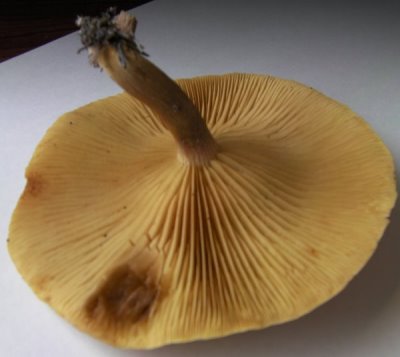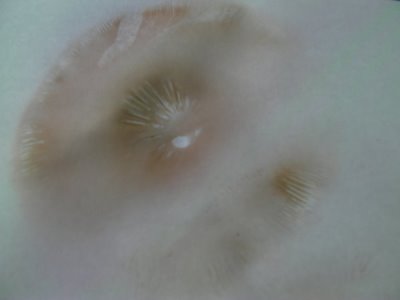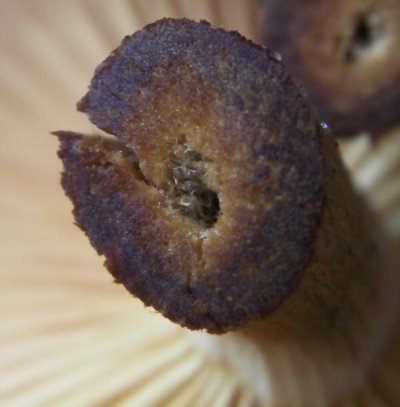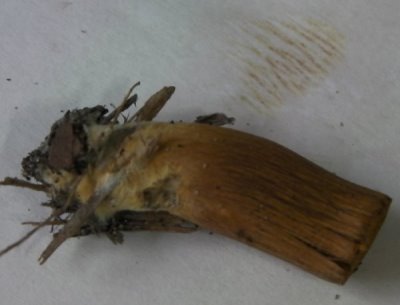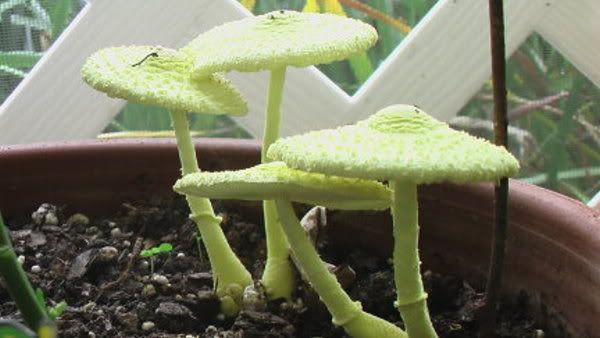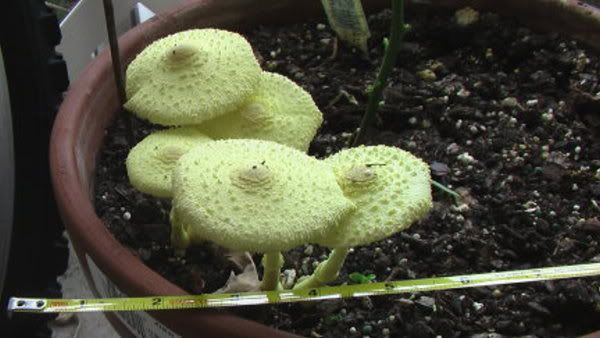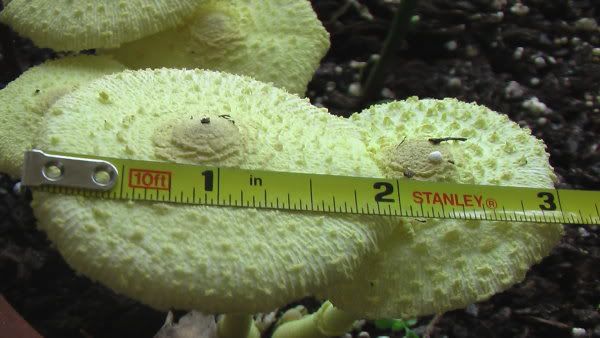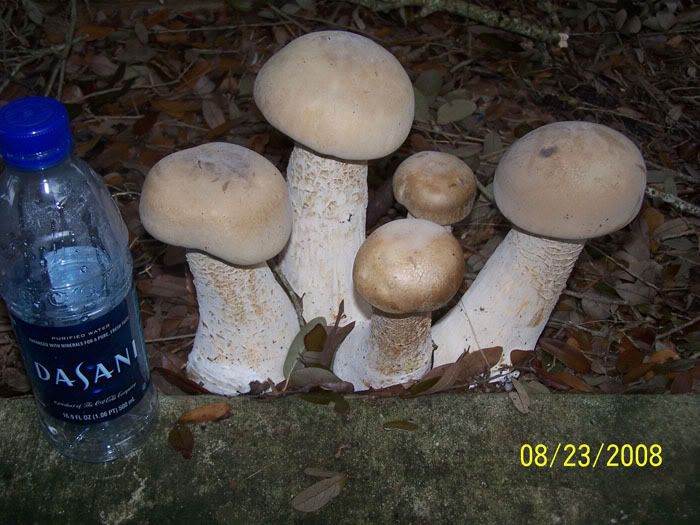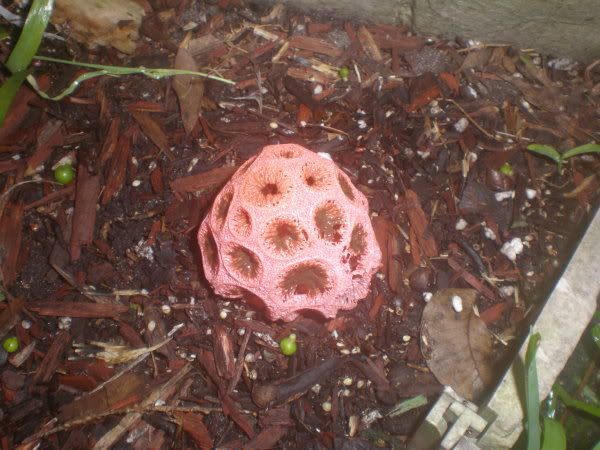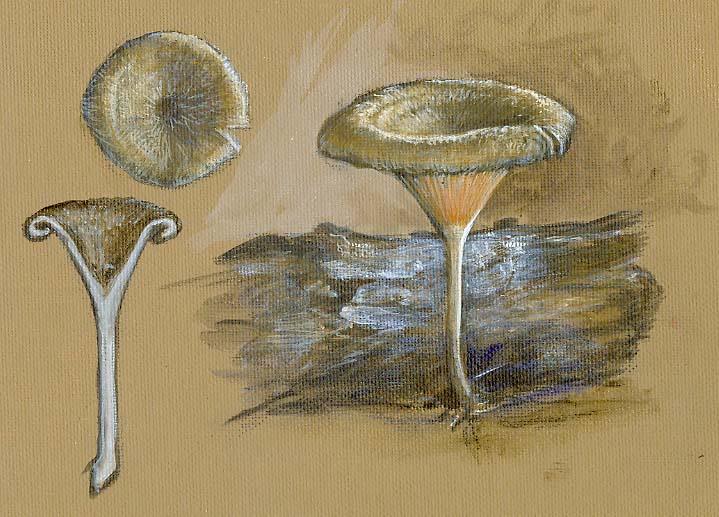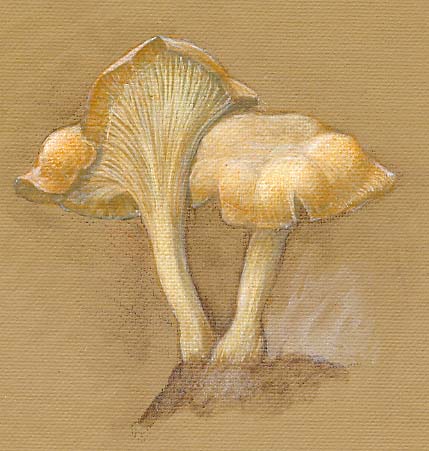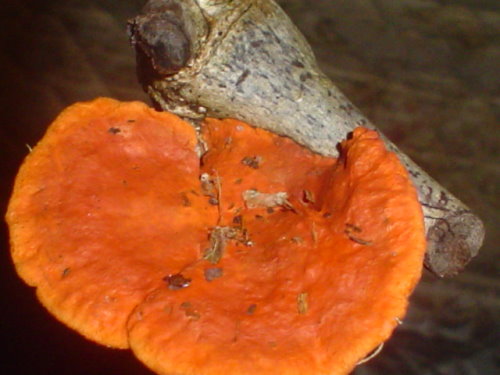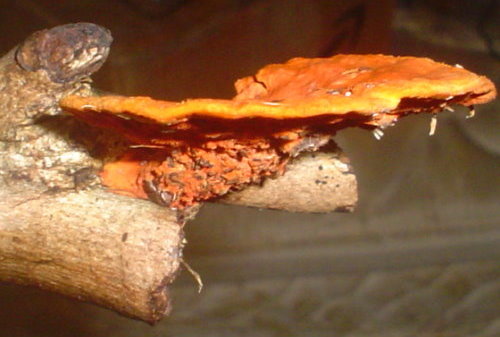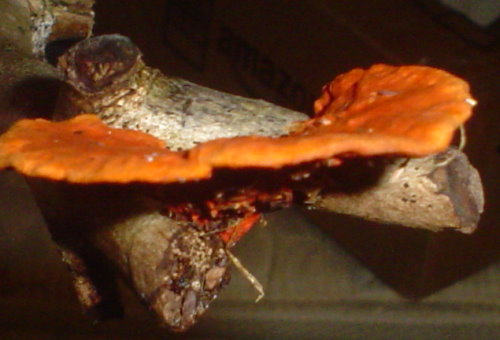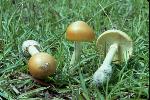Are you on Facebook? Find our page at |
Wondering about Fungi
To join the discussion about fungi identification, come on over to Bill's Florida Fungi page on Facebook! Question from Elizabeth Westmark: I am hoping you can identify a lovely mushroom that I saw in the Longleaf pine woods near Pensacola yesterday afternoon. It is dark mocha-colored with ruffled edges almost like a chocolate peony. Response from Bill: My research led me to Thelephor terrestris, but since many of the references were to a European fungus of the same name, I had some doubts. So did some of my contacts. One suggested I send the pix to Dr. Rich Baird at Mississippi State University because "he's good with such things." I'm pleased that Dr. Baird confirmed my identification. Those who know me know that I cringe at the thought of having to ID polypores, so, yay! Isn't this little chocolate mushroom a pretty thing? Couldn't you just eat it up? No! Wait! It's probably too tough to be eaten. ________________________________________________________________________
Excuse me, do you by chance know what kind of mushroom this is?
Response from Bill: I would say it's Parasola plicatilis. Here's a link: _________________________________________________________________________
Comment from Taylor Lockwood: Hi Bill, I've been looking for this for twenty years (Volvariella bombycina).
Photo by Taylor Lockwood
Response from Bill: Nice one, Taylor!! No chews, not too young or too old. I've seen it in the wild maybe 5 or 6 times but not in such prime condition, and I don't think I ever got a picture. __________________________________________________________________________ Question from Mike A.: Hi, Bill. I was out near the Indian Mounds by Lake Jackson today and saw
Response from Bill: Good to hear from you, Mike. Nice pix! I now call them Amanita jacksonii. Depending on where you look they may be called A. caesarea (Lincoff), A. hemibapha (Bessette, et.al.), A. umbonata (Smith & Webber), A. Jacksonii (Arora and most these days). It's interesting that these were found near the Lake Jackson mounds but I don't think that's where the name came from. The European variety (the "real" A. caesarea) is more robust than the American variety and most (but not all!) consider them to be different species these days. I'll have to see if any of my contacts can untangle the history of these names for us. Edibility: It's my policy to never recommend anyone eat mushrooms I've only identified from a picture on a computer screen. That said, A. jacksonii is a good edible. It was the first Amanita species I ever ate based solely on my own identification and it was a very exciting experience! The genus contains some of the most deadly fungi known to man and it's a very unpleasant death indeed. After enjoying a delicious repast I started having second thoughts like: "Good God! It was stupid to risk my life for a meal!" and "Should I go to the hospital and get my stomach pumped?" I did not sleep well that night, but, obviously, I am still here. In other words, sometimes fear itself can make you think you've been poisoned. __________________________________________________________________________ Question from Diane: I have these growing in my woodchips. I have no idea what they are but they stink. They
Response from Bill: Your fungus is a stinkhorn called Phallus ravenellii (how's that for an appropriate name?). It's common in wood chip mulch. Scroll further down this page and read what I said about another stinkhorn (Clathrus crispus). __________________________________________________________________________ Question from Karel P.: I was wondering if you have seen these before. They smell delightful and I was hoping it's edible. I found them growing in a 1-year-old flower bed with 4-inch layer of cedar mulch after our relentless rain the last 8 days. Cap is about 105mm diameter, stem is about 45 mm long and 8mm diameter. Gills are almost mustard color. Cap is smooth, spore print is brown, bruises dark brown, almost black. Gills are attached to the stem.
Response from Bill: Hi Karel: No names for these mushrooms come to my mind at this time. I will share your pix with some of my contacts and see if we get some suggestions. BTW, never eat a mushroom you have not identified to species and know to be safe. Update: The closest we could get to a name for this was the genus Pholiota. Because there are over 400 species of that genus in North America, pinning it down any further is virtually impossible without studying a dried specimen. __________________________________________________________________________ Question from Gordon C: As you can see by the attached photos, I found these little guys growing in my flower pot along with my jalapenos. They start off as a little 'button' and the next day they are just about where they are in the photos. When handled they leave a pollen-like yellow substance on your fingers. I hope they are edible; that would be a nice bonus to the little herb garden on our porch. Thank you for any light you can shed on the 'mystery mushrooms'. Response from Bill: Hello Gordon: If when you scratch the stem near the base, you get a red stain, it could be Leucoagaricus hortensis. __________________________________________________________________________ Question from Barbara S: Good afternoon Bill, Four days later:
Hi Barbara: Additional comment from James Kimbrough: "These are beautiful images of Macrocybe titans." __________________________________________________________________________ Question from Wanda H: Hey Bill
I've never seen this fungus in my area, but I have dozens of pix of it from your area. It's called Clathrus crispus. I've started calling it the "Whiffle Ball Stinkhorn". It's neat that you captured an image of the little fly chowing down on the gleba (spore mass). Stinkhorns love wood chip mulch. Most people want to know how to kill them, but I don't understand why (well, they DO STINK!). I think they are kinda cute! They are not harmful. They are saprophytes that break down organic matter, including wood chips. They have a mutualistic relationship with flies, which help spread the spores to your neighbor's garden. I DO NOT recommend use of fungicides. If you don't like them in your garden you can rake up the mulch to break up the mycelium, and if you see the "egg" forming, you can stomp on it and break the skin. Then the mushroom will not mature...or smell bad.
_____________________________________________________ Question 2 from Melinda Copper: Here's another, it was growing in the sun on wood chips with lots of friends. It doesn't look particularly appetizing, but I'd like to know what it is anyway...
Bill's Response: Another great drawing Melinda. I think your mushroom is Lentinus crinitus.Take a look at this link: http://www.cortland.edu/nsf/lentcrin.HTML There is a similar mushroom (that used to be) called Panus badius. It's darker, almost black, and usually has a long stem that extends down to burried wood. I was looking in James Kimbrough's (University of Florida/IFAS) book "Common Florida Mushrooms" and found something called Lentinus velutinus that seems a lot like what I called Panus badius. I think your mushroom is L. crinitus though. Note: Melinda Copper is a professional artist and botanical illustrator. Florida Fungi is pleased to display her detailed fungi renderings. _____________________________________________________ Question from Melinda Copper: I was wondering if you might take a look at my drawing and tell me
Bill's Response: That's a good drawing Melinda. I would easily recognize it as a chanterelle. Most likely it's Cantharellus cybarius but Cantharellus lateritius can be very similar. Both are edible. Cleaning them is hard if rain splashes grit up the stem and into the (false) gills. I wash the dirty ones using a soft brush and sometimes scrape the stems (under running water) with a knife...then chew lightly when I cook and eat them. I prefer to collect where the forest floor has lots of leaf (and/or pine needle) litter that prevents sand splashing onto the mushrooms. Chanterelles can be dried using a food dryer or they can be sauteed or parboiled and then frozen. There have been cases of people getting sick from eating chanterelles that were frozen without cooking. I have frozen them after sauteing in olive oil and butter and they were fine when I used them later. _____________________________________________________ Question from Pat S.: Hi Bill, I found your site awhile ago and wondered if you could help me identify a bright orange polypore I found on a decaying eugenia limb I must have clipped off a year before. I live the City of North Miami area. Is this edible or poisonous?
Bill's Response: I'm guessing your polypore is Pycnoporus sanguineus. Unless you have really strong teeth, you will not be able to eat this critter. No references to toxicity, but it's WAY too tough to be eaten. Most descriptions say: Not edible. Arora says of the closely related, but more northern species, P. cinnabarinus: Too tough to be edible, but makes a colorful ornament. _____________________________________________________ Question from Andrea: Do you know what these are? I live on Pine Island, Florida. Are they poisonous?
Bill's response: Your mushroom is Clathrus columnatus (the Columned Stinkhorn) or something closely related. It is harmless...certainly less toxic than the pressure-treated lumber I see in the background. They are one of the many stinkhorns that find Florida a friendly environment. They stink (a lot!), but will not harm you, your children, your pets or your garden. They love wood-chip mulch, which they decompose, making nutrients available to your plants. I get lots of queries about stinkhorns, and most people want to know how to get rid of them. I don't recommend that you use a fungicide. It will only temporarily kill the mycelium, and the mushrooms will return after a rain washes the fungicide down into your water table. You can break the "eggs" before the mushroom erupts and becomes mature and they will not stink. Just stomp them or hit them with a trowel or whatever and they will not mature. You can use a shovel to put any mature stinkhorns into your compost pile or bury them or whatever. Or you can just do like I do and say, "Hey! There's a Clathrus columnatus!" and show your kids the little gnats that are eating the gleba (the dark spore mass at the apex of the columnular arms). Then you explain how the spores pass through the gnat's gut and get pooped out (unharmed) in your neighbor's garden where they will make many new stinkhorns. ________________________________________________ Question from Mark: A friend took this attached photo of what we assume is a fungus of sorts. Could you I.D. it for us? I saw a very similar one in Hernando county (Florida) while his, pictured, was in the panhandle. Thanks for any help. Bill's response: See my above explanation to Andrea. This is also Clathrus columnatus (the Columned Stinkhorn). __________________________________________________ Bill's answer to David: Hi David: I just finished a response about the same fungus species to Andrea, so I'm forwarding it to you. I think I need to post that response on my web page since I get sooo many queries about this mushroom. ______________________________________________ Comment from David and Pat: Bill, love your web page. Try Ripartitella brasiliensis on your mystery mushroom. It should have brownish scales on the cap, but I could not tell from the photo if it had that condition. This species commonly fruits in mulch in large groups. Clark Ovrebo published an article in Mycotaxon several years ago about this species. Bill's Response: I'm glad you like the web site. I don't believe the mystery mushroom is Ripartitella brasiliensis. As you say, those have the fibrils on the cap and a little annulus on the stipe. The ones in my photo are glabrous (I have the advantage of being able to look at the original slide). This was one of the earliest pictures I took. I had thought they were Mycena at first, but changed my mind to Collybia as I learned more. _________________________________________________ Question from Aaron L. : This l ooks like a "Death Angel" to me. Could it be A. virosa? Bill's Response: It's an Amanita, but not A. citrina. _________________________________________________ Comment from Pete C.: The mystery mushroom below looks to me like the "Hated Amanita" according to my National Audubon Society Field Guide to American Mushrooms. I am by no means an expert since my only claim to fame is that I can find morels in Illinois when pointed in the right direction. On this past trip, we found 450 over two 4-hour trips. |
